Hype always works on me
Even when I know the ultimate source of it all is as sick as a demented chimpanzee, I still get sucked into it. The straw which finally broke the proverbial camel’s back this time round was a host of Eisner nominations by a group of esteemed judges: Best Continuing Series, Best New Series, Best Writer, Best Penciler/Inker, and Best Cover Artist.
I managed to avoid every single review of Matt Fraction and David Aja’s Hawkeye so as not to contaminate my ultimate pleasure in reading it. But there were still some whispered rumors that managed to creep through; that this wasn’t your usual superhero comic; that there was some new method at work, some new insight into the genre. And the first three issues of Hawkeye do hold that line to some extent.
It is possible to see an attempt to move away from the usual strictures of the superhero form, a settled and ceaselessly visited structure which has provided the template for most of the “classic” superhero storylines since the 1980s—the world or the superhero’s existence in great peril.
We see this in Daredevil: Born Again where a way of life is extinguished and The Dark Knight Returns where age is the great antagonist. The world is collapsing in Watchmen and that supreme god of goodness is taking his final steps in Alan Moore and Curt Swan’s Last Superman Story. Frank Miller and Bill Sienkiewicz’s Elektra: Assassin seems to break this pattern—the world is never really in danger of being nuked, the heroine enigmatic and never in any real danger; the ultimate premise being to watch Elektra fuck every person in existence to hell. Just one of Miller’s many wet dreams which he decided to share with us all.
The glue which binds most of the superhero “classics” of the late 80s is that atmosphere of persistent oppression, a mood thoroughly rejected by Grant Morrison in his take on Superman a decade later. But much earlier than that, J. M. DeMatteis, Keith Giffen, and Kevin Maguire were reimagining the Justice League as a sitcom in a series which still manages to strike a nostalgic twinge in a few older readers. Maguire’s facility with facial expressions was the foundation of that effort, and the new Hawkeye holds strongly to that sense of comedy though it has a different shtick: there’s the penile obstruction (a sly suggestion to those who would name their genitalia after superheroes)…
…the metafictional digs at language perception; and the fact that all the baddies have a penchant for the word “Bro” (among other things).
David Aja is the dominant partner in this collaboration, especially when it comes to the look and feel of the comic; showing enough chops to take on the mantle cast upon the closet drawer by David Mazzucchelli when he left superhero comics for good. If you don’t sense the evocation of late issue Born Again and Batman: Year One in the following page, then God help you.
The first page of the second issue shows that it wasn’t a fluke when Aja worked with Ann Nocenti on “3 Jacks.”
Fraction and Aja strip out the elements of a single action sequence: the symbols which mark the villains and the heroes; the graceful diagonals of the page broken into small panels and moving from left to right; the bodies swaying in a danse macabre; the twins guns ringing out like a silent soundtrack; an evolved form of Steranko stylishness and page breakdown. It’s all as sweet as the candy which J. H. Williams III used to lace his Batwoman in times past. You and I could care less about the story.
But there it is, weaved thoroughly into the mythos of the Marvel empire. Right from the start, we get the hints and the nods, the insider knowledge needed for the insider fun. The ability to link descriptions of the Avengers with their likenesses and their names; the ability to identify a Marvel rogues gallery; the ability to know who Iron Fist is (and that Fraction and Aja once worked on the character); the ability to thrill at the sight of a third string villain like the Ringmaster because you read The Incredible Hulk and Steve Ditko’s Amazing Spider-man as a kid; the ability to actually care who these people are.
The Ringmaster’s stage is a homage to The Cabinet of Dr. Caligari (the third issue pulls in The Italian Job) and Aja’s action scenes are consistently stylish…
…the spell broken only by the words and ideas. The second issue seems as well plotted as television’s Arrow, the youth oriented, touchy-feely version of Green Arrow. When Clint Barton (aka Hawkeye) thinks, “Thieves. Working a very long con,” you wonder whether you missed anything apart from the obvious, television-lite set-up which preceded the unveiling of a forgettable super villain. Those expecting Mamet-like moments of intrigue following on those words will be sorely disappointed.
Barton in these issues is a bit like Chandler’s Phlilip Marlowe without the cool dialogue, machismo, and active mind—he’s basically a plains clothes knight of the city who gets beaten up a lot. He uses fists not words and is bereft of any trace of deep intellectual content or motivation. He’s just another nice guy in an unending stream of nice guys in popular culture. He never dies; no, he can’t die because no one actually wants to kill him. They just want to tell him that he’s going to die like every weirdo in the Marvel universe. If readers came here even remotely excited that this was a comic which takes the superhero into hitherto unknown territory, let me dampen that down right now.
The excitement here is that Hawkeye doesn’t wear his costume all that much and acts like a real life human being once in a while. He cracks some jokes and has some sense of his own mortality when he or his friends get shot at. He is hopeless at superheroics (i.e. fallible). He also has to make rent for his poor neighbors, just like a rich Peter Parker would do (except that, you know, Spider-man was poor). Also, he gets to hang out with a bunch of babes. The bar has been lowered to the level of a Munchkin.
The collected Hawkeye (which reprints #1-5) helps us ascertain where Matt Fraction ends and David Aja begins. Issues 4 and 5 of Hawkeye remain as empty of story interest as issues 2 and 3 but stand in stark contrast due to the absence of Aja. Javier Pulido stumbles hard in his first issue and Clint Barton comes out looking like a paper doll in parts.
Pulido retrieves a bit of his dignity in some of the action sequences in issue 5.
That fifth issue did make me read up a bit on Operation Eucritta (say this with a Southern accent if you will). Apparently it’s this:
“An Avenger? On tape committing the assassination of the world’s most wanted criminal terrorist?”
Hawkeye has to retrieve this tape before it’s released to a mass audience of baddies assembled at a private auction in Madripoor.
Before confirming the real line of reasoning behind this plot, I had imagined that it would be just bad PR all round for an Avenger to be seen killing the Marvel Universes’ equivalent of Osama bin Laden, one Du Ke Feng. Of course, doing the same has been such excellent business for President Obama that he’s decided to extend the program to any Tom, Dick, or Harry acting suspiciously. So out with that!
The Marvel database tells us that the Avengers doing the assassinating were Captain America, Wolverine, and Hawkeye; except that those tapes were fakes created to obscure the identities of a bunch of Navy SEALs (the real hit team) and to flush out a spy in SHIELD. Hawkeye has to prevent the auctioning of his personal tape (lost accidentally) because it would put his life in danger.
What?
People need an excuse to kill Cap, Wolvie, and Hawkeye? I thought supervillains did this for free every day of the week but mostly on shipment days? I think they usually arrange to destroy the universe at least once a year as well. No extra charge.
The end of issue 5 is where superhero fantasy meets “real” life, a special corner of heaven where Fraction becomes as solemn as Denny O’Neil in his Green Arrow drug issue:
“The guys that actually did this — they’re doing what they think is right. They didn’t sign up to get their families and friends killed as retribution.”
Except in real life, the terrorists, freedom fighters, and soldiers attached to the individuals assassinated don’t need names to enact “retribution.” They simply kill and maim the soldiers and citizens of the offending nation(s)—a simple and evident fact that is erased in favor of platitudes and cameos by the Kingpin and Nick Fury. In this make-believe world where bad men practice evil for indefinable or ridiculous reasons, violence becomes necessary and inconsequential. The only reasonable answer to violence is more violence.
The new Hawkeye comic is barely acceptable to aging fans and a thorough going embarrassment to those who have promoted its excellence. I would liken it to going back to a middling diner you haven’t been to in decades and discovering that they’ve changed the uniforms. The food? Probably just as bad as ever.
_______
Further Reading
Sean Collins on Hawkeye #2-3
“…it feels like Matt Fraction poured a bunch of unrelated ideas into a Hawkeye-shaped vessel because that’s what was available. I’m not saying there’s some One True Hawkeye out there, I’m saying I don’t think Hawkeye, One True or otherwise, is anything but an extraordinarily flimsy frame on which to hang surface-cool writing like this.”
Tucker Stone on the first issue of Hawkeye.
The Comic Books Are Burning in Hell gang thinking out loud on the possible reasons for the prodigious levels of adulation heaped on the comic (starts around 19 min).
David N. Wright at Graphixia – “Hawkeye and the Problem of Comics as Art.” Comparing a later issue of Hawkeye (not reviewed above) to the work of Chris Ware. The real kicker comes at the end. Doesn’t this all sound rather familiar:
“Fact is, comics stand in relation to art like the internal combustion engine stands in relation to the steam engine: they may well be andecendants, but to think of them in this way does nothing to help us understand either. That comics are often a collaborative, usually repetitive, almost always recycled endeavour opens spaces for new conversations about the nature of the medium. These conversations must occur outside the already established aesthetic principles of artistic production in precisely the same way that a discussion of the steam engine must stand outside a discussion of an internal combustion engine. Comics are a multi-mediated and re-mediated form of practice and cultural production that can only be defined within its own contexts—a context that more than justifies its significance as the most relevant form of twenty-first century aesthetic practice—and that means it can’t be art or Art… or, mercifully, stand in relation to either.” [emphasis mine]
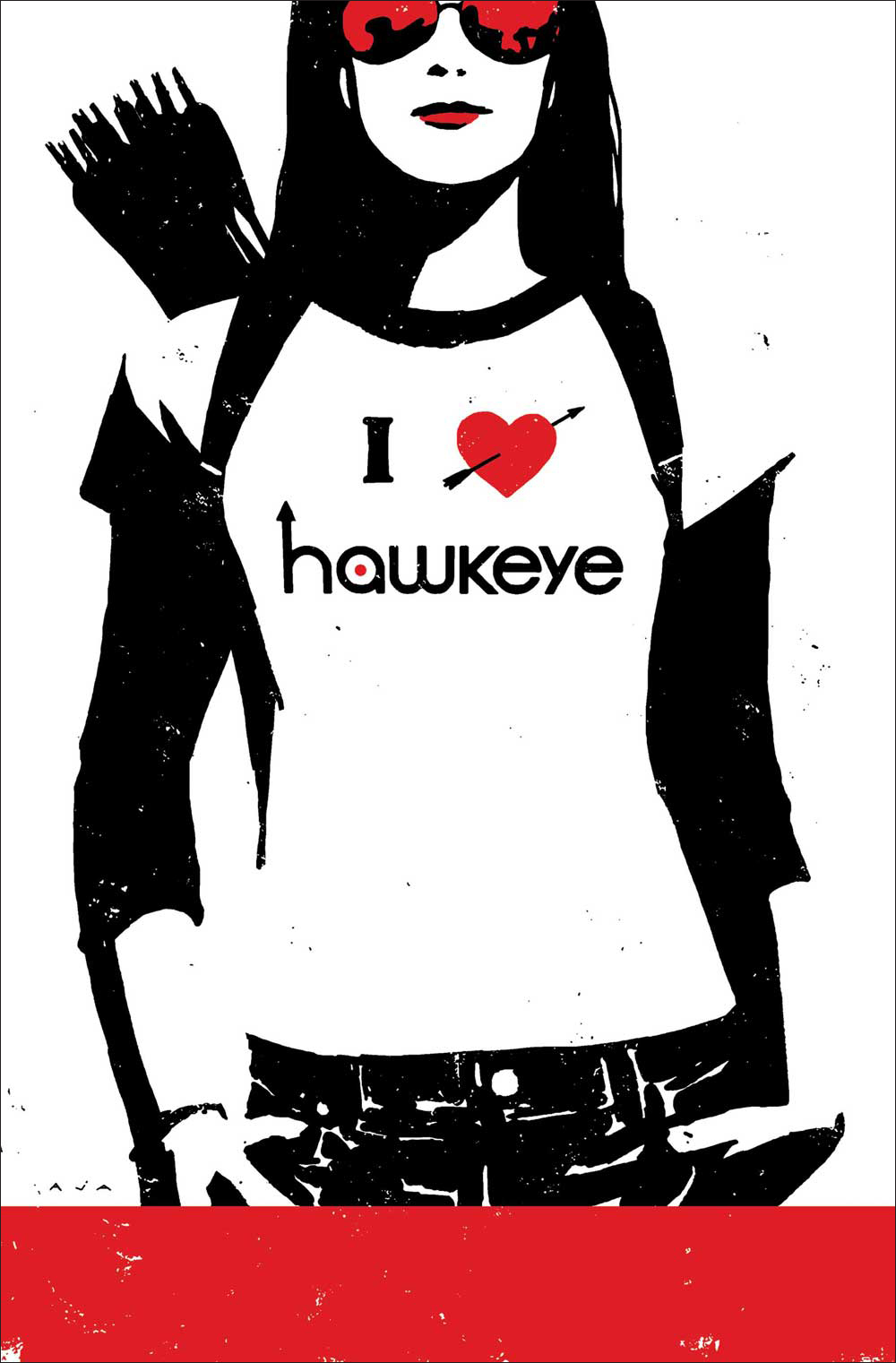
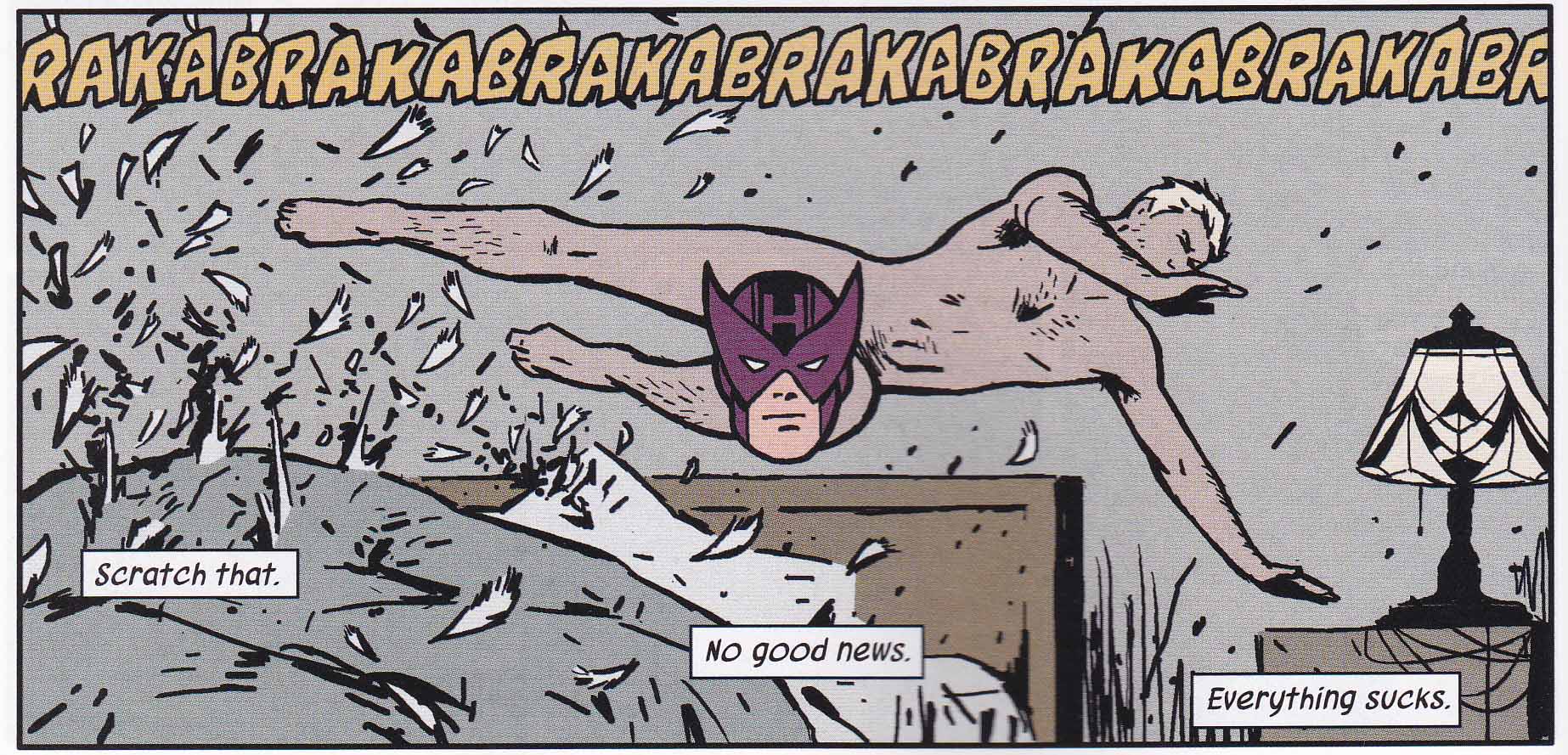
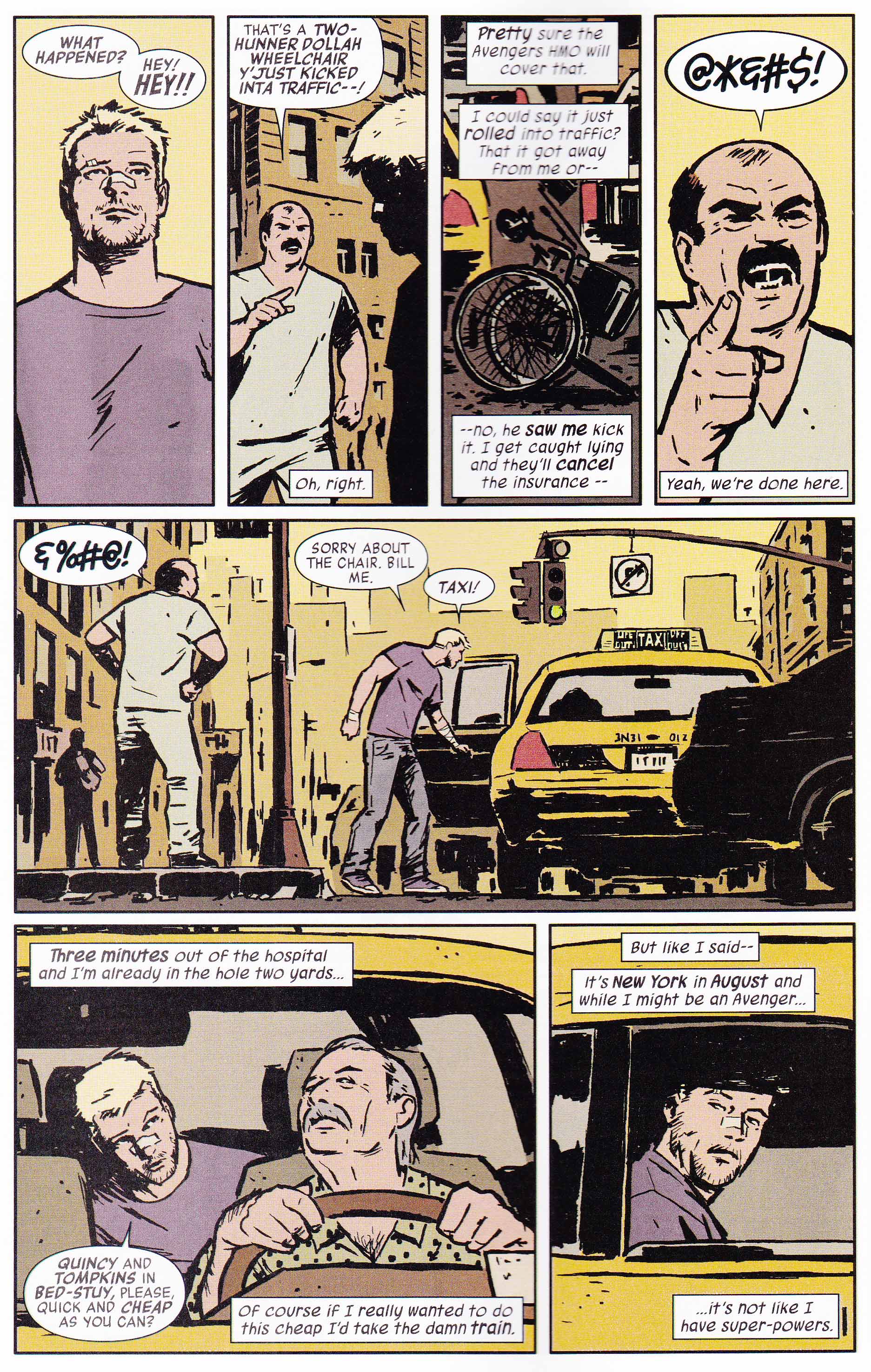
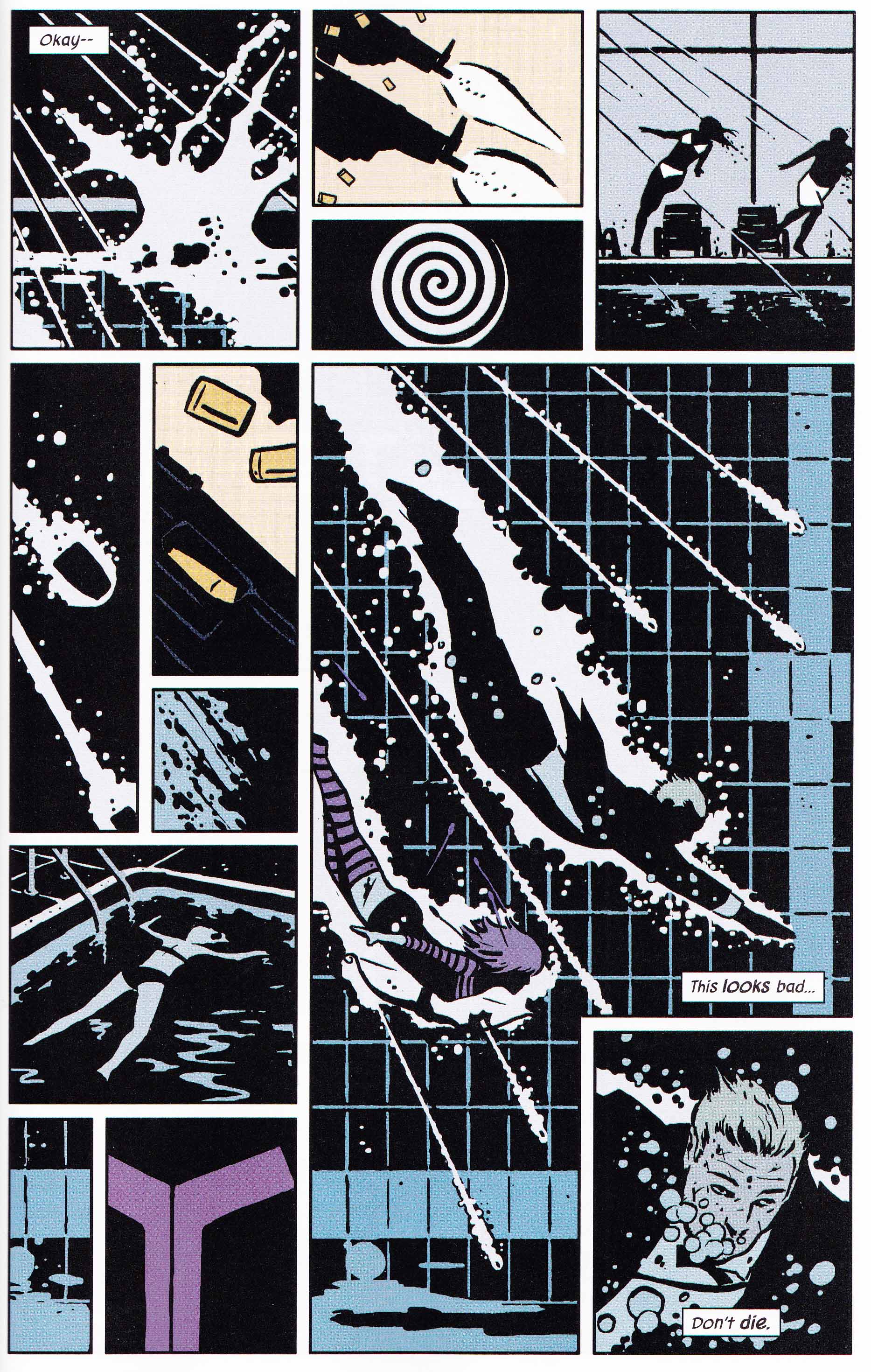
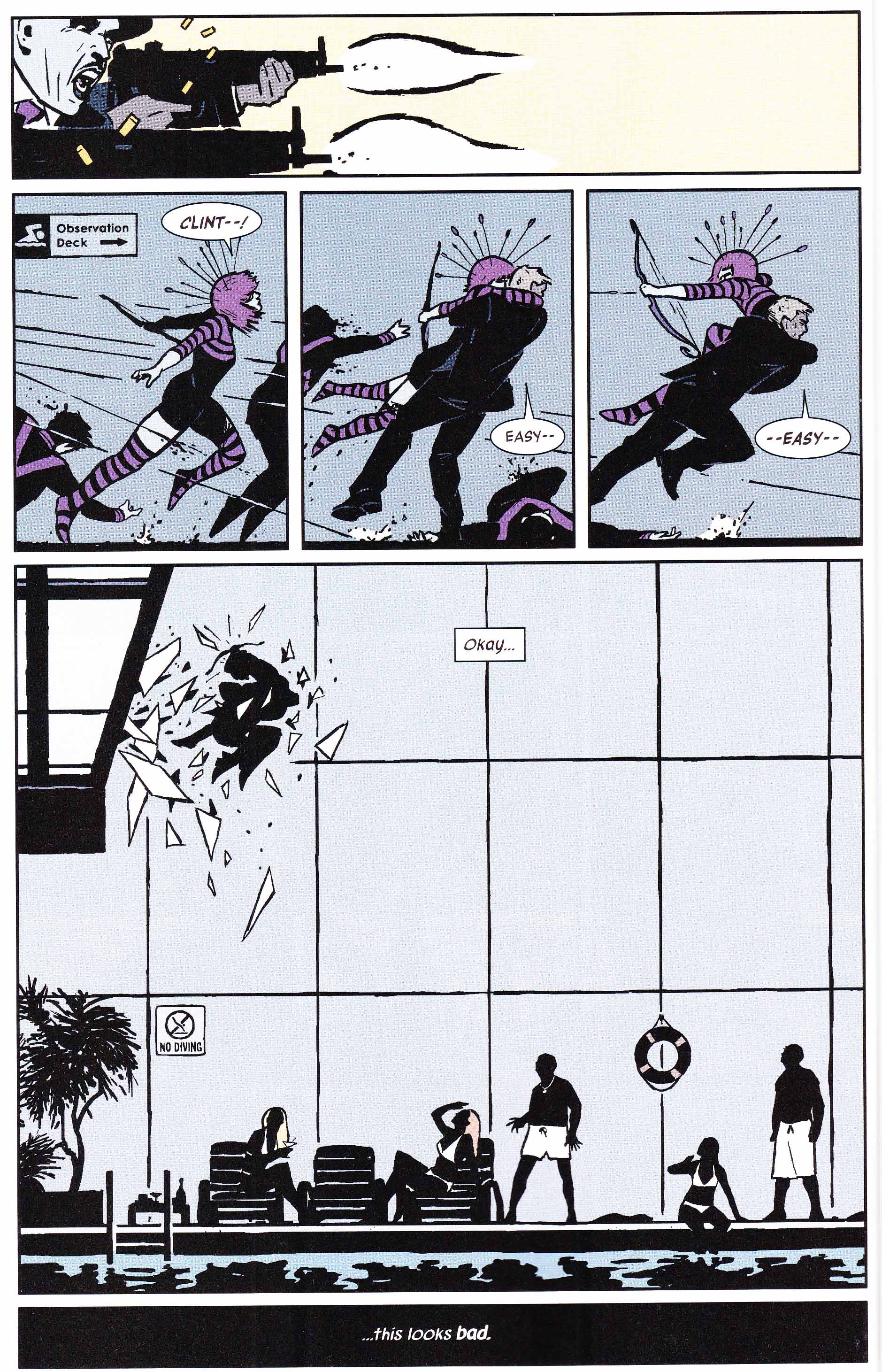
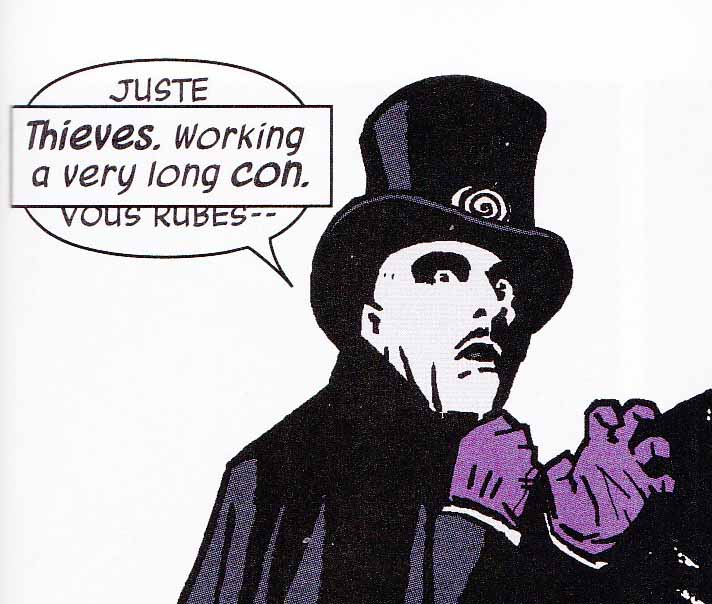
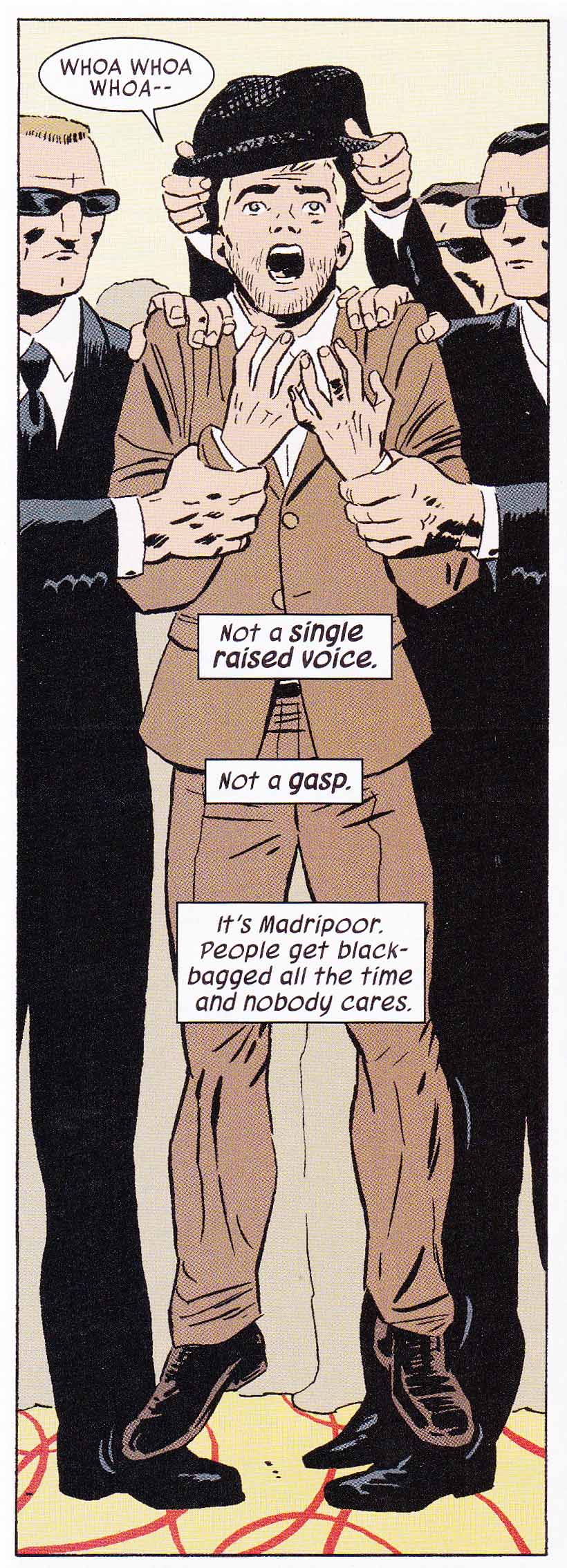
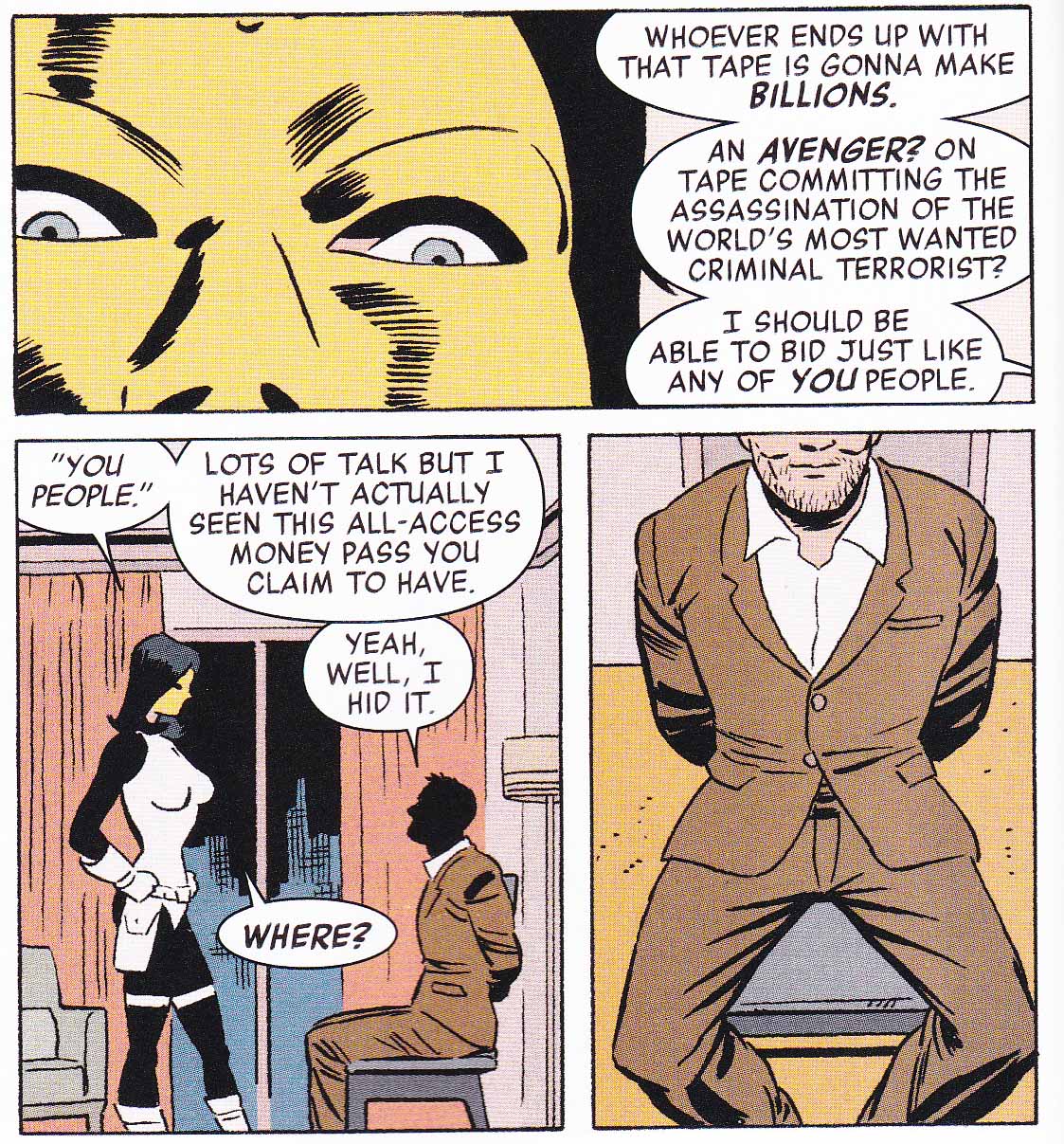

Glad to see some correction to the hype surrounding this book.
I read the first two issues a while back and wrote the following about it in an email to a friend:
“It felt to me like the book is a Frankensteinian combination of other comics, in particular it reminded me of Brubaker’s Catwoman run. (I have no way of knowing if it was really an influence, it’s just how it felt to me)
Hawkeye gets comically beaten up by thugs in issue 1- ending up in a hospital, which is like Slam Bradley’s schtick in Brubaker’s Catwoman.
Hawkeye pines for a girl too young for him in issue 2- like Brubaker’s Slam Bradley in the Catwoman book.
Hawkeye steals from thieves in issue 2 and they swear revenge, like Brubaker’s Catwoman (and it made a whole lot more sense for the Catwoman character).
Apparently the book has a lot of Frank Miller influence (according to a critic I read) in issue 2 Hawkeye’s sidekick shoots arrows in people’s eyes and Hawkeye thinks “They’ll live, they’ll just have a crappy life.” which seemed very hard boiled Frank Miller Dark Knight Returns but made no sense in the context of the book.
In all these cases it felt to me like the tropes were being played out but were meaningless because they lacked the original context that Brubaker or Miller had, and lacked their own context that made any sense. “
That paragraph by David Wright is baffling. No other art form is collaborative? No other art form ever includes flagrant homages or swipes? Not other art form is imitative or repetitive? Does he never look at any art other than comics?
I’m sure he just got carried away, but for pity’s sake…
Hmm, the beaten up thing is definitely meant to be a running joke since Hawkeye gets beaten up quite a bit even in later issues. It’s also there to show his humanity and frailty (cf. the rest of the Avengers).
Miller is teensy bit more serious about the violence – you’re supposed to enjoy it but it’s still meant to be what it is. Fraction’s approach is more Wile E. Coyote. You can see that even in the much touted first scene where Hawkeye is laid up in hospital for 6-8 weeks (?) with serious injuries and then makes a full recovery in terms of his shooting abilities and agility etc. The rest of the beatings he more or less shrugs off in a matter of panels.
Best issue of Hawkeye might be #6 but most of that is down to Aja’s page design once again. There are some catastrophic issues later on.
“Hmm, the beaten up thing is definitely meant to be a running joke since Hawkeye gets beaten up quite a bit even in later issues”
Yeah, its also a running joke in Catwoman with Slam Bradley. here’s a page where’s he’s beaten up by Batman
http://www.4thletter.net/wp-content/uploads/2006/08/Catwoman22pg21.JPG
Ha, more evidence that when a headline ends with a question mark the answer is always “no”.
(I like all those Aja panels though.)
To me it’s “who cares?”
It’s a question mark which has many correct answers. It might even be answered “yes” or “really” (with another question mark and a look of incredulity).
It’s almost as if it was a superhero comic or something and people liked it. How dare it! My semiotics thesis is useless in relation to Little Lulu!!! Very old manish arguments abound and that David N. Wright quote is a piece of dogshit from someone who probably should go outside and live in a cabin somewhere instead of yelling at the comics he tricked himself into buying and feeling shame that it was fun and maybe nothing more than just that. The “there were no good superhero comics since Born Again or Dark Knight or the very aware that they were poking fun at superhero comics JLI” is tired and almost senile at this point and not worth any consideration because that isn’t objectively true. That’s like saying film should’ve stopped with How Green is My Valley or music should’ve ended with The Platters. There is the door. You can leave at anytime. Part of the problem with comic criticism is there are a lot of people holding guns to their heads looking at Mark Millar comics. Sure you can go over to Gilbert Hernandez but even that’s not enough. Hawkeye is a lot of fun. Like a Hitchcock film. Like a Sherlock Holmes story. I’m sick of “Is comics art” question because that’s something the community itself is denying because of aesthetic reasoning that does not exist or even really matters. Hawkeye has its influences, influences you can say are better(Steranko) but their from the exact same vineyard of comic book art. One is just a finer vintage than the book that is a year old. A book that a lot of people like and enjoy for being fun and enjoyable and not this semiotic thesis that no one but you wants to read. Nobody got into this medium because of Umberto Eco.
Errrrr nobody gets into comics at all do they.
Unless they are kids and dad creates them. Which they will grow out of.
But that’s bullshit because even though reviewers apparently hate superhero comics for being what they are they still have to write about them instead of the latest Leo Carax film. Comic journalists still feel the need to cover the hobby that once made them happy and now hate for some reason and I think that speaks more about how horrible comic journalism culture is than comics themselves. This is trolling or robots trying to understand what human emotions are. Comic criticism does not know what it wants. This is just prime picking because people happen to like it and it is successful. If this was failing there might be a different story here. It has nothing to do with “Comics are a multi-mediated and re-mediated form of practice and cultural production that can only be defined within its own contexts” which is bullshit or it being embarrassing to the aging fan because that’s bullshit. The only thing this article accomplishes is getting me to write in a comments section.
Sashamak, Suat says he wouldn’t be writing about it except it’s been critically acclaimed. So he checked it out and was disappointed and said so. Why this needs to provoke an existential crisis about comics journalism is unclear to me…but I guess if that makes you happy, knock yourself out.
FWIW, I enjoyed the review significantly more than I’d enjoy the comic, from what I can tell. Maybe rather than getting all upset about how the review isn’t what you want it to be, you could just enjoy it? It’s fun! Why do you need it to be something more than that?
Sashamak: “The only thing this article accomplishes is getting me to write in a comments section.”
A rather dubious accomplishment, indeed…
yeaaaaaaahhhhhh BUDDY
<3
I just bought the first collection of this book… Now I really need to read it.
That Sean Collins review is hilarious, by the way.
The podcast is funnier and more venomous than anything I wrote above. But since no one took the time to listen to it (or maybe because Tucker and gang are a friendlier bunch), no one bothered to complain about it online either.
Domingos: I always aim to encourage dubiousness…
non-rhetorical question: when was the last time you weren’t disappointed by a new “critically acclaimed” superhero comic? It took me a long time too, but I eventually learned to stop trying to kick that football.
(BTW, that’s one hell of a mixed metaphor in your opening para…)
Maybe All-Star Superman? It’s become fashionable not to like it but I’ve come round to it. I didn’t like it on my first read through but then I reread Moore’s Last Superman Story and realized that it didn’t hold up (and might be even worse). So whoever (Mark Waid?) wrote the introduction to the collected editions was basically right when he implied that it was one of the best Superman stories ever written. I’m sure there are a lot of jokey-fun vintage Superman stories (Bizarro ones?) out there but I can’t think of one which could be considered, within reason, good. So the hype in that instance might have been correct – one of the best Superman stories.
Just out of curiosity, did you grow up reading Schwartz/Weisinger Superman comics? I did and for me, Moore’s Whatever Happened To The Man Of Tomorrow not only holds up, I can (and do) go back to it and I find it every bit as wonderful as I found it when it originally appeared. But I freely admit that most of this has to do with where I was personally/emotionally with regard to comics of this sort – ready to move on to other types of comics, but still emotionally invested in the comics of my youth. I strongly suspect that Moore approached the story from a simile angle and oddly enough, I think it’s actually one of Moore’s most personal stories. He’s often declared his own love for the old version of Superman and even credits the character with having helped to form his ideas of morality to a far greater degree than religion ever did. Moore knew that this version of Superman had been declared obsolete and that it deserved a nice conclusion and a happy ending and he provided it beautifully. By contrast, his For The Man Who Has Everything Superman annual from a few months earlier was simply a great example of what you could do with the character (indeed, it’s probably a stronger standalone story than Whatever Happened…) while mining a similar vein of nostalgia.
I like Moore’s last superman story a lot better than All-Star Superman, I have to say.
I think All-Star Superman is probably better than Morrison’s batman though. FWIW.
Yeah, that’s what I thought before I reread. Now I think they’re closer in quality. Pretty good argument for not rereading old comics and living with your delusions.
Daniel: The first Superman story I read was a Bill Finger/Wayne Boring reprint but the Superman I’m most familiar with is from Curt Swan’s long tenure. So those Moore/Swan stories should have worked and did. On the other hand, I’ve never been a big fan of the character. The Moore story (with all its “guest stars” and neat ribbon endings) relies a lot on a nostalgia which I simply don’t have even though I’m familiar with virtually all the plot lines being depicted. So my memory of it is far greater than I anything I can get out of the comic nowadays. Same reason why I dread rereading Miracleman.
I never reread All Star Superman, but it seemed to me like an exercise in flattering fan-boys by throwing in a bunch of religious iconography to make their insular hobby seem important. It’s no surprise a fan writer like Mark Waid might like it, but I’m curious why you do Suat.
The religious iconography is not even original, as it was done in the 1978 Superman film, which I would rate much higher.
I wouldn’t care to disagree especially since I remember so little about it except the art. The question in my view is whether it deserves to be on a list of best superhero comics of the last decade. Just like above, Hawkeye could well be the best superhero comic of 2012 for all I know. I find that totally believable.
Moore’s story relies even more on fanboy flattery and memory. It’s like one slice of nostalgia after another. If a reader didnt know/care who/what the LOSH, Supergirl, Krypto, or Kandor etc. are, the story falls apart. It doesn’t even try to make you care as far as I can remember.
I actually wasn’t familiar with those things when I read Whatever happened to the Man of Tomorrow and I enjoyed it- but I did read it when I was a teenager so may have been more inclined to read it earnestly, and i haven’t really felt the need to revisit it. (Though I love the two covers, and enjoy looking at them again!)
I think the main difference with All Star Superman is Moore tends to write from a perspective of familiarity with comics culture but is somewhat outside it, so instead of the theme being how awesome Superman is (All Morrison cares to discuss, seemingly) its more of a loss of innocence/ growing up sort of theme.
Its in some ways a bittersweet farewell to Superman, not a gushing celebration.
Suat…it’s definitely building on Superman’s mythology and past. It’s addressed to a knowledgeable reader in that sense. But the point of the book is ultimately that supeheroes are kind of stupid and useless, and you don’t really need them. All the childishness is childish; best to grow up, though you can still have a place in your heart for the silliness.
The Morrison, on the other hand, as Pallas says, basically tries to convince you that Superman is really consequential. Which I have trouble taking even marginally seriously.
Best superhero stories of whatever time period are always going to be a somewhat low bar. I still think Marston/Peter is great art, though. Damn it.
My personal and probably idiosyncratic view of Moore’s 1986-era DC output is that it’s a perfect final chapter of superhero comics for readers who are ready to move on. Yes, Whatever Happened To The Man Of Tomorrow depends on the reader’s prior knowledge of the character and all its convoluted (and ridiculous) backstory, but to my way of thinking, that’s a strength, not a weakness. Yes, it’s a bittersweet as Pallas notes, but it’s also a nice conclusion. I knew that this version of Superman was going away, but the fanboy in me still wanted to know: so how did his story end? And I was entirely satisfied. I don’t really see it as Moore saying that superheroes are “stupid and useless” as Noah suggests, or rather, I see it as Moore saying “yeah, they’re kind of dumb, and I’ve got better things to think about, but I love them.” Not so different from your Marston/Peters love perhaps?
OTOH Watchmen does seem to take this point of view. Moore takes a look at what’s going on “under the hood” (hence that recurring phrase, with its two distinct meanings) and he doesn’t really like what he sees. Same with Miracelman. But apparently for a lot of fans and later writers (including Moore himself), these were blueprints for the future rather than final summaries.
As for Morrison, I am utterly indifferent what little of his stuff I’ve read and haven’t felt compelled to seek out more. I saw an issue of ASS which was included as part of FCBD a few years ago and it certainly didn’t seem awful, but I didn’t seek out further issues either.
Dan, you’re right; I overstated. There definitely is affection there…but I think there’s also a real sense of the genres’ problems and weaknesses. To have Superman saying at the end that the world doesn’t need superheroes is definitely a critique…though one that still sees Superman as having some moral authority. So, yeah, bittersweet and complicated.
Re my Wonder Woman love. First of all, it’s “Peter!” No “s”! If you put on the s, you lose the full wonder of the name “Harry Peter.”
Second…my appreciation of Marston/Peter is not much like Moore’s appreciation of the Superman comics, I don’t think. I really think the Marston/Peter WW is great art. Like, legitimately great art. Better than The Great Gatsby, for example, by a fair bit (and I even kind of like the Great Gatsby.) Marston/Peter is strange and beautiful and passionate and surprising and funny and wise. I really have no ironic distance. It’s just great.
D’oh!
Well I’m not a Marstonist, so I’m not really qualified to speak. :-)
There’s also that bit in ASS where Superman creates himself, thus removing entirely the need for Siegel and Shuster — which is pretty gross, in the context of his later remarks about those two.
“There’s also that bit in ASS where Superman creates himself,”
That’s part of the religious iconography.
Warren Ellis ran a parody of Morrison’s Supergods book on his web site, and the parody says
“Officially, DC didn’t like to use the word “creator” as it made it seem like they didn’t have 100% ownership over the characters, so instead the creators were called “vessels.” These superhero creations traveled from the ether of Jesus’s Fluffy Imaginorium, where they were plucked and ushered via the humanly “vessels” into the gentle hand of the company.”
I think this is the sort of stuff Morrison is about. It’s not even really a parody…
That book does seem like a major reason why his fanbase turned on him. But you don’t really need that book to decide that ASS was average to above average at best.
Daniel (and Noah): “I don’t really see it as Moore saying that superheroes are “stupid and useless” as Noah suggests, or rather, I see it as Moore saying “yeah, they’re kind of dumb, and I’ve got better things to think about, but I love them.””
I think it’s easy to put a gloss on both the Moore comic and ASS to make them seem better than they are. The proof is in the reading. Even just recalling the bare storyline of ASS, you could say that it’s a meditation on the essence, longevity, and importance of the character (both metafictionally as the progenitor of the superhero form and within the DC universe). Moore’s putting aside childish things approach doesn’t necessarily equate with quality any more than treating superheroes “seriously” (a la Watchmen or ASS) automatically means shite.
To me, Moore’s comic succeeds or fails at the level of its ability to evoke that warm fuzzy feeling of nostalgia. In that sense, it’s better to remember how great your Playmobil set once was than actually trying to play with it again. Your mileage may vary of course.
Damn it, Suat! This is trolling or robots trying to understand what human emotions are. Why can’t you just accept Alan Moore for what he is?
Gore my sacred cow, will you…
Eh…Moo!
BTW, I fully confess that my love for Whatever Happened To The Man Of Tomorrow is entirely personal and probably has as much to do with the fact that it was drawn by Curt Swan and Kurt Schaffenberger (with those fabulous “Swanderson” covers) as it does to Moore’s rather fannish plot (whose ending, as Morrison has gleefully pointed out, owes a lot to Robert Mayer’s novel Superfolks). It’s those elements in *combination* (the ultra fannish plot, touching on everything from Titano the Super-Ape to Elasti-Lad to Krypto!) in concert with the much loved Swan/Schaffenberger art that produces such a strong emotional reaction in me. I pulled down my copy of the hardcover reprint edition (with its strange Brian Bolland cover redo of the original “Swanderson” cover to ACTION #583) from the shelf to check on a couple of details and read the ending again and felt that same damn lump in the throat that I got in 1986. Heck, if I’d pulled my copy of the original issue out of the comic boxes and read it in all its pre-digitally colored newsprint glory I might have even sniffled a bit.
Your Playmobil analogy still stings, but yeah, my mileage does indeed vary!
BTW Noah, the thing I was checking on in the book was what Supes actually says wrt to superheroes at the end, which is: “Superman? He was overrated, and too wrapped up in himself. He thought the world couldn’t get along without him. What’s for dinner?” That may still be seen as a critique of superheroes in general and it’s interesting that you remembered it differently.
—————————
pallas says:
…I think the main difference with All Star Superman is Moore tends to write from a perspective of familiarity with comics culture but is somewhat outside it, so instead of the theme being how awesome Superman is (All Morrison cares to discuss, seemingly) its more of a loss of innocence/ growing up sort of theme.
Its in some ways a bittersweet farewell to Superman, not a gushing celebration…
—————————–
Indeed (aside from that “talent” thing), that neatly summarized “perspective of familiarity with comics culture but…somewhat outside it” is what makes Moore so valuable a contributor to the art form.
Moore can fully appreciate he charm of silliness such as Krypto, the Bottled City of Kandor, etc., and is thoroughly acquainted with all that backstory and “mythology.” But, being well aware of what is outside comics in art and science, he can enrichingly mix in those factors. His deep knowledge enables his criticisms of superheroic tropes to be more insightful and cutting than those coming from outsiders, who attack oversimplifications and distortions.
—————————–
Jones, one of the Jones boys says:
non-rhetorical question: when was the last time you weren’t disappointed by a new “critically acclaimed” superhero comic? It took me a long time too, but I eventually learned to stop trying to kick that football.
——————————
Nicely (and hilariously) put! Come to think of it, that “perspective of familiarity with comics culture but…somewhat outside it” could sure be of benefit to many comics critics, as well.
I’ve been reading a lot of the eminently quotable H. L. Mencken lately. A relevant section, from his 1917 “A Book of Prefaces”:
——————————
The cause of this profound and almost unbroken lack of critical insight and enterprise, this puerile Philistinism and distrust of ideas among us, is partly to be found, it seems to me, in the fact that the typical American critic is quite without any adequate cultural equipment for the office he presumes to fill. Dr. John Dewey, in some late remarks upon the American universities, has perhaps shown the cause thereof. The trouble with our educational method, he argues, is that it falls between the two stools of English humanism and German relentlessness — that it produces neither a man who intelligently feels nor a man who thoroughly knows. Criticism, in America, is a function of this half-educated and conceited class; it is not a popular art, but an esoteric one; even in its crassest journalistic manifestations it presumes to a certain academic remoteness from the concerns and carnalities of everyday. In every aspect it shows the defects of its practitioners.
The American critic of beautiful letters, in his common incarnation, is no more than a talented sophomore, or, at best, a somewhat absurd professor. He suffers from a palpable lack of solid preparation; he has no background of moving and illuminating experience behind him; his soul has not sufficiently adventured among masterpieces, nor among men…Even on the side of mere professional knowledge, the primary material of his craft, he always appears incompletely outfitted. The grand sweep and direction of the literary currents elude him; he is eternally on the surface, chasing bits of driftwood. The literature he knows is the fossil literature taught in colleges — worse, in high schools. It must be dead before he is aware of it. And in particular he appears ignorant of what is going forward in other lands. An exotic idea, to penetrate his consciousness, must first become stale, and even then he is apt to purge it of all its remaining validity and significance before adopting it…
Coming down to our own time, one finds the same endless amateurishness, so characteristic of everything American, from politics to cookery — the same astounding lack of training and vocation. Consider the solemn ponderosities of the pious old maids, male and female, who write book reviews for the newspapers. Here we have a heavy pretension to culture, a campus cocksureness, a laborious righteousness — but of sound aesthetic understanding, of alertness and hospitality to ideas, not a trace.
——————————
——————————
Daniel C. Parmenter says:
My personal and probably idiosyncratic view of Moore’s 1986-era DC output is that it’s a perfect final chapter of superhero comics for readers who are ready to move on.
——————————–
Yes; it’s like playing with beloved toys one last time, before going to more “adult” things.
Those “ironic” quotation marks are a nod to the fact that “adult” things need not necessarily be more mature, wiser.
As Moore and Don Simpson showed in their splendid “Pictopia”: http://aseasonedtaste.blogspot.com/2010/11/alan-moore-and-don-simpsons-pictopia.html?zx=b01fb37d13c4fa28 , they can just be sleazily sexual, emptily “grim n’ gritty”…
—————————–
…about seven years ago, DC decided that they didn’t like the Justice League comic that Giffen and DeMatteis had done, and killed, raped, or raped then killed, almost every character that had featured in it. This trend reached its peak in a comic called Countdown To Infinite Crisis, co-written by Geoff Johns, commissioned by Dan Didio, and with cover art by Jim Lee, in which the Blue Beetle, a whacky lovable superhero who got into humorous scrapes with his friends, was shot in the head by one of those friends, with lots of lovingly-rendered blood coming out of Beetle’s head…
——————————
Re one of the “Watchmen” prequels, that site goes on to note, about Darwyn Cooke’s “Before Watchmen: Minutemen 1”:
——————————
…this is a typical first issue of a typical superhero team-up comic these days, which means we have little unconnected vignettes introducing all the characters — Dollar Bill, Silhouette, Silk Spectre, Nite Owl, Hooded Justice, Captain Metropolis, The Comedian and Mothman.
These little bits show us aspects of the characters that were already there in Watchmen, but with a hammering lack of subtlety that reads as if Cooke had never heard the phrase “show, don’t tell”. Worse, they do nothing else — we’re expected just to be happy to see these characters again. Which would be OK if the characters weren’t obvious ciphers. Wanting to read more stories about Hooded Justice is the same sort of error of thought as wanting to read more stories about Mr Worldly Wiseman and Giant Despair. They’re not built to be characters, and if you want to tell a story about them you have to turn them into characters.
Which Cooke here fails to do. It’s POSSIBLE to do it — you *CAN* write a story about Hollis Mason and the rest of the Minutemen, but you’d have to take the attitude of Tom Stoppard in Rosencrantz And Guildenstern Are Dead. You have to put characters in where none previously existed — you have to remake them totally into something that can hold the weight of a story.
But this is too ‘reverent’ a comic to do anything like that. It’s ‘paying homage’ to Watchmen, and of course in comics one pays homage to works of unbridled creativity and imagination by having absolutely no original ideas of one’s own. As Jack Kirby was meant to have said when someone told him John Byrne was doing Fantastic Four ‘in the style of Jack Kirby’ “If he was doing it in the style of Jack Kirby he’d have invented his own characters.”
—————————-
In painful contrast, look at what Moore’s writing did with Rorschach, a deliberate knock-off of Mr. A, intended to be a critique of that character and simplistic black-and-white moralistic thinking. Instead of the unsympathetic creation he originally had in mind, Moore couldn’t help but add richness, depth to him. Moore was too much the artist to make Rorschach into a political cartoon of a right-winger…
—————————–
Noah Berlatsky says:
Damn it, Suat! …Gore my sacred cow, will you…
—————————–
It’s worth pointing out that — besides their position as symbolic stand-ins for the Divine, selflessly giving nourishment — there’s a very down-to-earth reason for the reverence accorded bovines in India. Were they to be seen as mere meat to be eaten, they’d be swiftly devoured. Instead, their “cow patties” are collected, dried in the sun, and serve as a free and invaluable fuel for cooking fires…
“The Great Alan Moore Reread: The Superman Stories”: http://www.tor.com/blogs/2012/02/the-great-alan-moore-reread-the-superman-stories
Mike: That Tor.com “rereader” seems to take the position that For the Man Who Has Everything is the Real Deal Alan Moore Masterpiece, not the mere “laundry list of allusions and drive-bys” of Whatever Happened to the Man of Tomorrow?. Mileage as usual varying, but I suppose he’s not completely wrong either and I can only assume he doesn’t share my particular emotional connection to the era of Swan/Schaffenberger etc.
As an aside, around the same time (1986-ish) that I was getting all misty-eyed and putting aside childish things over Moore’s Superman, I was also first introduced to Kurtzman/Elder’s brilliant (and indisputably canon-worthy) Goodman Meets S*perm*n thanks to Kitchen Sink’s 1984 Goodman Beaver reprint volume. (Here’s the original version as it ran in HELP! http://ethunter1.blogspot.com/2009/09/sunday-funnies-goodman-beaver-help.html)
Kurtzman/Elder’s version of the retired Man of Steel hasn’t killed anyone or relinquished his powers, he’s simply given up on humanity with a big “feh!”. Of course Kurtzman/Elder also touch on the Superman/Clark/Lois triangle and Supes’ desire (as noted by Jules Feiffer and others) to be loved for “the real fake me”. Moore skates around this by disposing of Clark Kent at the very beginning of his story. Lois ends up with Jordan Elliot, manly and mustachio’d auto mechanic (exactly like Nite Owl 1/Hollis Mason in Watchmen, natch!), not Clark Kent, the wimpy reporter with glasses.
I wouldn’t call either “For the Man Who Has Everything” or “Whatever Happened to the Man of Tomorrow?” a “masterpiece”; but certainly the former is a more solid, satisfying story…
And, thanks for that splendid “Goodman Meets S*perm*n” link! (Why, Elder’s inking style reminds of Jim Woodring’s…)
I just found the link to this from a link in the comments of Ng Suat Tong’s “Best Online Comics Criticism of 2013.”
Personally, I enjoy the Hawkeye series quite a bit. It is a lot of fun and snappy if somewhat uneven and occasionally lazy (but what isn’t?).
I did write about its use of setting, Bud-Stuy, somewhat critically, however: Do-Or-Die Hawkeye. . . Erm. . . Bed-Stuy
I read this at a friend’s place and felt for the title character… he reminded me of my uncle, that kind of depressive personality that puts everyone else’s problems first before his own. Dude must have lost so many brain cells doing stupid stuff, he probably has that degenerative brain disease football players get.
Pingback: 25 Superhero Graphic Novels To Binge Read Right Now | The Viral Beat